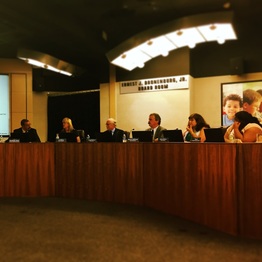 SDCOE Board Meeting PC: npriester SDCOE Board Meeting PC: npriester Public Opinion Initiatives impacting public education in California represent the opinions of some Californians. According to Public Policy Institute of California (2014), “Likely voters are disproportionately white. Whites make up only 44% of California’s adult population but represent 62% of the state’s likely voters.” This disparity is not new. It has existed since the funding of public schools began to transition from the local to state level in the 1970s. California Opinion Index (2009) states that in 1978, 83% of the voters were white non-Hispanic but they only represented 68.9% of the state’s population. Even though the discussion around financing public education focuses on low-income and high-income school districts, it is important to remember that race is also tied to these communities. The majority of low income American families are racial minorities (Simms, Fortuny & Henderson, 2009). Their opinions are currently not proportionally represented in voter initiatives. However, the current trend to move control of school district funding back to a local level is providing an avenue to include all community members in making decisions about how school funding is allocated. Judges and Homeowners According to Townley and Schmeider-Ramirez (2015), “During the second half of the 20th century, a series of court decisions, propositions, and legislation resulted in a shift from property taxes to other forms of taxation as the primary source of funds for education in California. This change resulted, to a significant degree, in transferring local control of education to state control.” These changes also benefited homeowners but hurt low-income school districts. California’s schools were established using an unfair financing system based on local property taxes. Since this system operated for more than the first hundred years of California’s statehood with little disruption, it is logical to conclude that public opinion supported this system. However, the courts corrected this mistake in 1968. Serrano vs Priest decided that using property taxes as a primary source of school revenues “violated the right of students to receive an equal education” because the taxes did not provide equal funding for all schools (Townley & Schmeider-Ramirez, 2015). This decision impacted the financing of education by requiring the state to help supplement and balance district funds. The California Supreme Court’s decision followed Serrano’s attorneys’ arguments which were supported by the 14th Amendment of the US Constitution and the Education Clause of the California Constitution rather than popular opinion (Townley & Schmeider-Ramirez, 2015). The court’s decision created challenges for the State of California, but it also supported financing the education of students in low-income communities. As evidenced by the passing of Proposition 13, voters strongly valued property tax cuts in 1978. According to California Opinion Index (2009), 66% of registered voters were homeowners in that year. It is likely that this population supported Howard Jarvis and voted in favor of Proposition 13 without considering its effect on public education. According to Kermer and Sansom (2013), the passing of this proposition “resulted in a centralized system of school finance that slowed the growth of per-pupil expenditures.” It seems the voters were driven by personal financial gains and may have not even looked ahead to evaluate how the cuts to education this proposition produced could negatively impact the their communities. According to Townley and Schmeider-Ramirez (2015), “the nation, state, local community, employers and taxpayers” benefit from education. However, Californians seem unwilling to pay more to support schools. Back to Schools Even though voters seem resistant to increasing statewide taxes to support education, they are willing to support initiatives that move funding control to a local level. Governor Jerry Brown has led this effort in with Proposition 39 which reinstated general obligation bonds to allow school districts to vote to increase local taxes to fund district construction projects (Townley & Schmeider-Ramirez, 2015). Additionally under his leadership, schools are currently able to allocate their funding using Local Control Funding Formula (LCFF). Returning control of funding, which still comes from the state, to districts has the potential to include local opinions when deciding how to fund schools. However, in my experiences in my district so far, it seems that more work needs to be done. I recently attended the May 13, 2015 San Diego County Office of Education (SDCOE) Board Meeting during which the SDCOE Local Control Accountability Plan (LCAP) 2015/2016 Update was presented. At the conclusion of the presentation, Board Vice President Gregg Robinson commented that he was surprised and disappointed there were no public comments or questions. The next week, I attended an LCAP training hosted by the California Teachers Association and learned how teacher, parent, and stakeholder opinions should be woven into the plan. I began to understand Dr. Robinson’s frustration; if teachers, parents, and stakeholders were invested in the LCAP, they most likely would have provided opinions at the board meeting. Hopefully, SDCOE can continue to work to bring all of those invested the education of our students into decisions about how to spend our funding. LCFF gives our district the opportunity to be guided by the public opinion of our community--instead of just white homeowners. References Bibliography A digest summarizing The Changing California Electorate. (2009). Retrieved May 31, 2015, from http://www.field.com/fieldpollonline/subscribers/COI-09-Aug-California-Electorate.pdf Just the Facts: California's Likely Voters. (2014, August 1). Retrieved May 31, 2015, from http://www.ppic.org/main/publication_show.asp?i=255 Kemerer, F., &; Sansom, P. (2013). California School Law Third Edition. Palo Alto: Stanford University Press. Simms, M. C., Fortuny, K., &; Henderson, E. (2009). Racial and Ethnic Disparities Among Low-Income Families. PsycEXTRA Dataset. http://doi.org/10.1037/e724082011-001 Townley, A. J. & Schmieder-Ramirez, J. H.,. (2005). School finance: a California perspective. Dubuque, IA: Kendall/Hunt Pub. Co.
0 Comments
Leave a Reply. |
@npriesterEvidence of my learning from SDSU EDL 600 Principles of Educational Administration Archives
August 2015
Categories |
 RSS Feed
RSS Feed